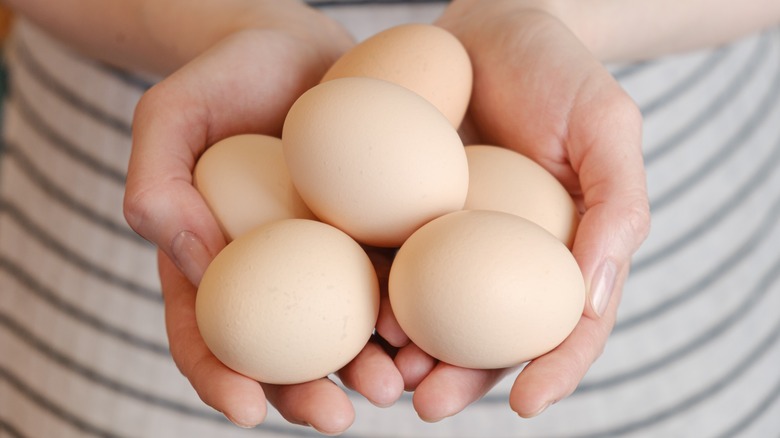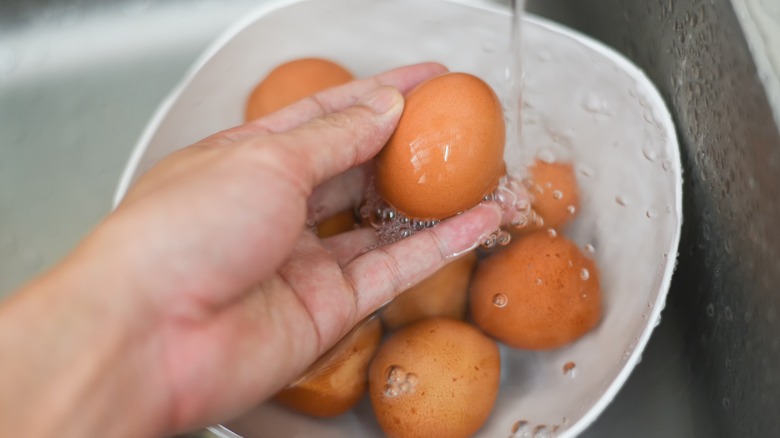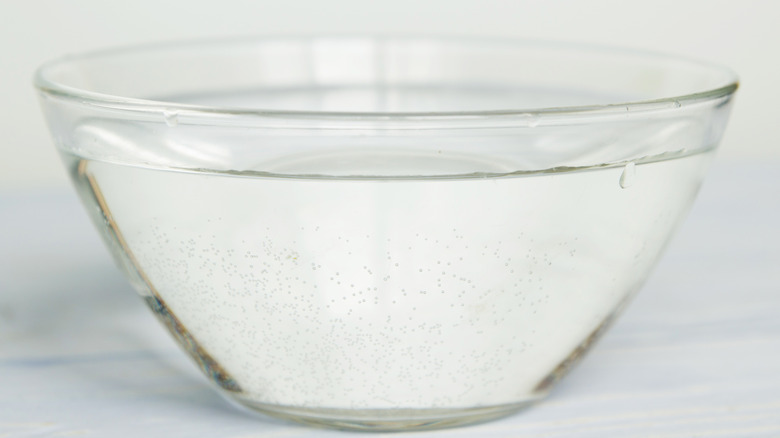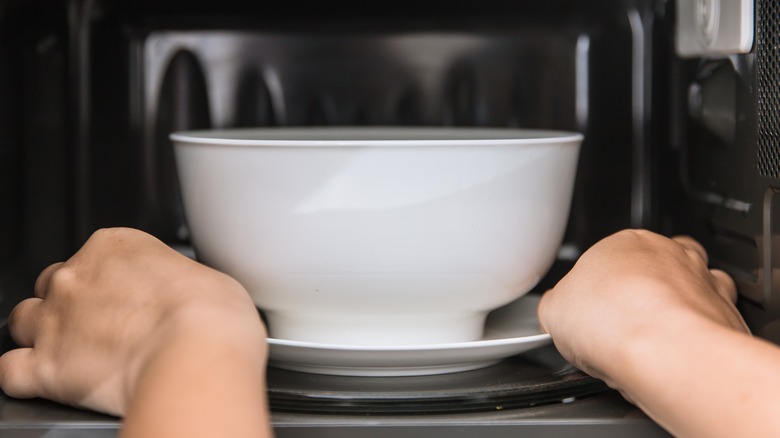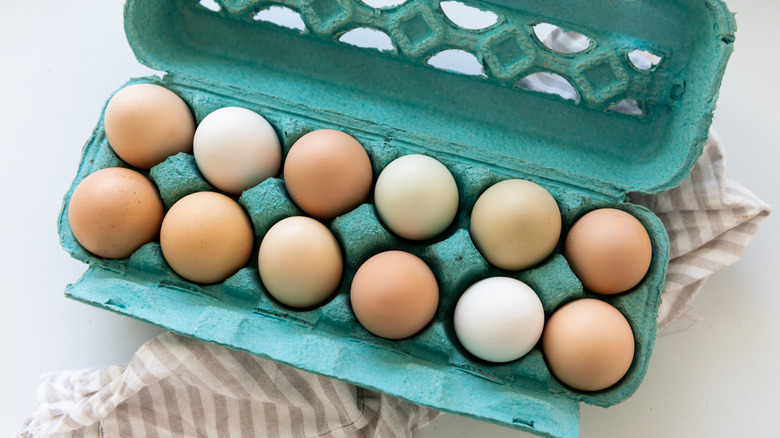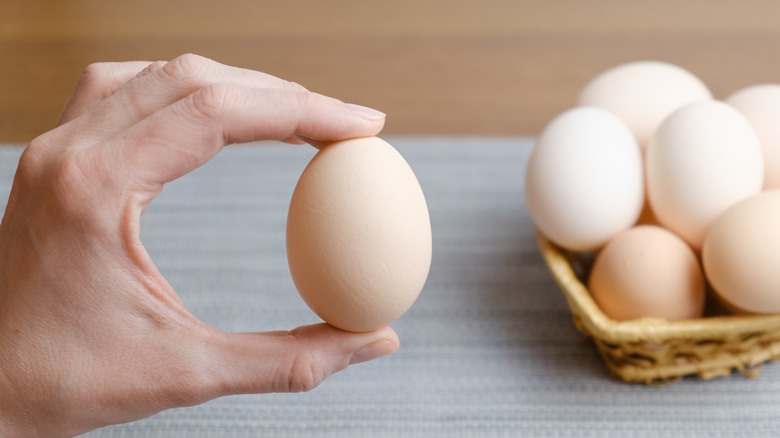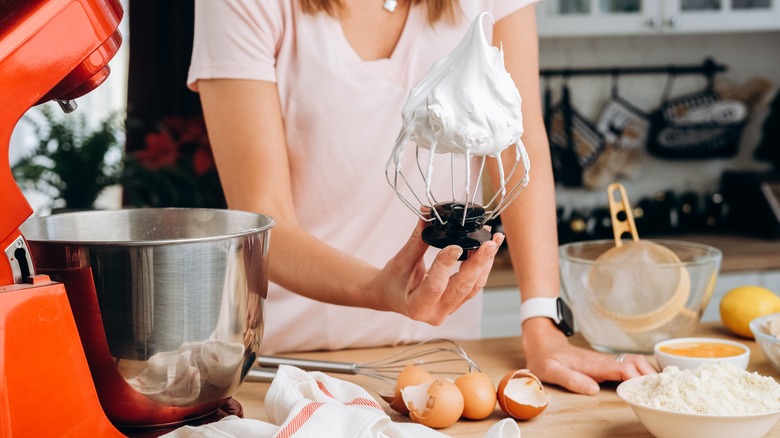The Best Ways To Get Eggs To Room Temperature
Achieving the perfect cheesecake texture or meringue whip doesn't require cooking lessons or fancy equipment. In fact, the secret to elevating your culinary creations is simpler than you might think. We're even willing to bet that you already have all the tools and know-how you need. So, what is this ridiculously simple trick? The secret lies in the temperature of one humble ingredient: eggs.
In this article, we'll delve into why using room-temperature eggs is the key to improving the quality of your baked goods. Beyond that, we'll share five methods you can use to get your eggs up to room temperature. Besides detailing the techniques, we'll share how long each method takes so you can better plan your next baking session. Something as simple as warming up your eggs might seem too good to be true, but we promise you'll see and taste the difference the next time your treats come out of the oven.
Run eggs under warm water
When you've got two dozen cookies to make in an hour and your eggs are a chilly 35 degrees Fahrenheit, this is the tip for you. Of all of the hacks we cover in this article, running cold eggs under warm water is the fastest method we've found for getting eggs to room temperature. Thankfully, this method is as easy as it is effective.
To warm up eggs in a jiffy, place however many you need into a large bowl. Turn the tap to warm and let the water flow over the eggs for two minutes. When the timer dings, check the egg temperature by touching the shell with your fingertips. If it still feels cool, go back to running warm water over the surface. At most, this technique should take roughly five minutes in total.
While we're big fans of the warm running water technique, it's important to note that this method wastes a lot of water. For that reason, we recommend steering clear if you've got time to spare or if you're trying to save energy in the kitchen. Another caveat worth mentioning is the temperature of the water. Warm is the keyword here. It's tempting to raise the temperature, especially when you're short on time, but using hot water will backfire. Basically, if the water is too hot, your eggs could start cooking inside their shells.
Place eggs in a water bath
If you've ever researched effective ways to get eggs to room temperature, then there's a good chance you've stumbled upon the water bath method. This is arguably the most common technique, and perhaps the most effective one as well. Plus, compared to the running water method, a warm bath uses almost no water.
Set up the water bath by filling a large mixing bowl with warm water. Again, make sure the water is bath-like, not scalding – you don't want to accidentally cook the eggs before you start baking. Plan to use about 1½ cups of water per egg. Your eggs should reach room temperature within five to 10 minutes. However, the actual time may vary depending on how many eggs you're warming up and the temperature of the water. As always, use your fingertips to test the temperature. If your eggs feel warm to the touch, then they're ready to use. Because there's a bit of waiting involved with this technique, we recommend warming up your eggs before you start pulling out your ingredients and measuring cups. That way, your eggs will be ready just in time to start baking.
Cover the eggs with a warm bowl
Although this method isn't one you'll find on a lot of websites, it's just as effective as other egg-warming techniques, so it's worth mentioning. To prepare, set up a plate or other flat surface and a large mixing bowl. Next, warm the bowl. There are two ways to do this. If you're working with a smaller, microwave-safe bowl, then toss it into the microwave for 30 seconds. On the other hand, if your bowl is too big or is made out of metal, fill it with hot tap water and let it sit for a couple of minutes.
Once your materials are ready, it's time to warm the eggs. Place them on the plate, then cover with the warmed bowl. Leave them under the bowl for about 10 minutes. After your timer goes off, touch the eggs to see if they're warm. If they are, go ahead and start baking. If not, let them sit for a couple more minutes. Past ten minutes, you'll probably need to warm up the bowl again.
How to warm separated eggs
The first three hacks mentioned in this list (warming eggs under running water, letting eggs soak in a water bath, and placing eggs under a hot bowl) work wonders for getting whole eggs to room temperature, but they're not ideal for recipes that call for separated eggs. That's because egg yolks break easily at room temperature. For this reason, you should separate your eggs into whites and yolks while they're still cold.
After you've divided your eggs into two small bowls or ramekins, place the containers into a high-sided pan filled with hot water. Pay attention to the word hot here. Unlike the whole-egg techniques that require warm water, separated eggs need a hot water bath. Essentially, the water has to be hot enough to penetrate the bowl and warm the eggs. In addition to checking the water temperature, make sure you verify the water level. You want the water to come up halfway on the bowl. The eggs should warm up within five to 10 minutes, but stir occasionally to ensure heat distribution.
Can you leave eggs on the counter to warm them?
These techniques are great, you might be thinking, but wouldn't it be easier to just leave the eggs out and let them reach room temperature naturally? If you don't need them right away then, yes, feel free to set your eggs on the counter. Depending on the temperature of the room, the eggs should take anywhere from 30 minutes to two hours to reach room temperature. Sounds good, I've got another episode of Top Chef to catch up on, you might be saying, but not so fast. While this quote-on-quote natural method can work, it may not always be a safe option from a food safety standpoint.
According to the United States Department of Agriculture's egg-handling guidelines, refrigerated eggs should not be left out for more than two hours. As cold eggs warm, they sweat. This perspiration makes it easier for harmful bacteria like salmonella to enter the egg and spread. As long as you keep an eye on the time you should be able to use your eggs safely, but we can't emphasize enough how important it is not to pass the two-hour mark. It's also worth noting that this two-hour limit isn't a hard and fast rule. If the outside temperature is greater than 90 degrees Fahrenheit, you should only leave the eggs out for one hour maximum, per the USDA. Higher temperatures mean faster bacteria growth, meaning you've got less time in the safe zone.
How to tell if eggs are at room temperature
Before we explain how to tell if eggs are at room temperature, it's important to understand exactly what room temperature means. In the simplest terms, room temperature refers to the measurement on a thermometer in any given room. Ideally, room temperature refers to the temperature range in which it's comfortable to wear normal clothing. A comfortable range is between 68 and 72 degrees Fahrenheit. Basically, if you're sweating through your crop top or layering on wool sweaters, the room you're in isn't at room temperature.
Applying this concept to eggs means that they no longer feel cold when you touch the shell. A room-temperature egg will feel tepid or slightly warm. Although the shell-touching technique is perfectly acceptable, it's not super accurate. Nor does it work for separated eggs. Instead, you can use an instant-read food thermometer to measure the temperature more accurately. Once the temperature is between 68 and 72 degrees Fahrenheit, your eggs are ready to use.
Why is it important to bring eggs to room temperature?
If you're anything like us, you've probably blown right past the recipe directions asking for room-temperature eggs more times than you can count. Surely it couldn't make that much difference, right? Unfortunately, using cold eggs is one of the biggest egg mistakes we see on a regular basis. Believe it or not, room-temperature eggs are better than cold ones in almost every way (poaching and separating being two notable exceptions).
Even something as simple as boiling works better with pre-warmed eggs. Because of the temperature difference between the boiling water and the cold eggs, the shells have a tendency to crack, leading to waterlogged eggs instead of nicely boiled ones. On top of that, the temperature difference causes the egg white to cling to the shell, making peeling a real challenge. Room-temperature eggs are also better for frying. If you fry cold eggs, there's a chance you'll overcook the yolk while waiting for the white to solidify.
The most common use for room-temperature eggs, however, is baking. The proteins in room-temperature eggs are more flexible than those in cold eggs, making them easier to blend. This means more cohesive batters and doughnuts. Besides this, warmer eggs hold liquid, air, and sugar together, leading to lighter, fluffier treats.
